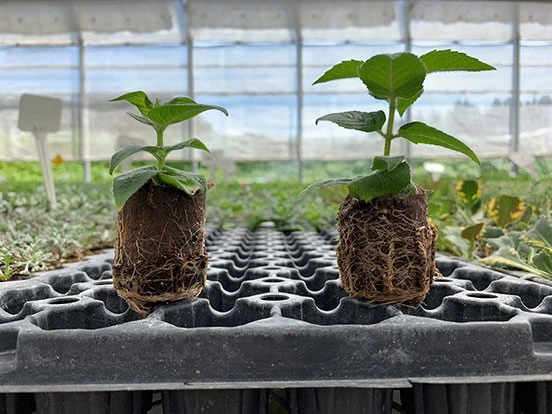
Mycorrhizal Applications
What should growers know about mycorrhizae and how it can help their plants?
Plants have evolved several mechanisms to interact with microorganisms to acquire nutrients and water from the soil. One of the most widespread mutualistic relationships is arbuscular mycorrhizal symbiosis, which is formed by arbuscular mycorrhizal fungi (AMF) in association with the majority of land plants including almost all major agricultural and ornamental crops and herbaceous and shrub species in natural ecosystems. The symbiosis is characterized by carbon (e.g., sugar, lipid) flows from the plant to the fungus and inorganic nutrients and water movement to the plant, thereby providing a critical linkage between the plant and the soil.
The AMF, after the colonization of the root tissues, develop an external mycelium which is a bridge connecting the root with the surrounding soil microhabitats. Mycorrhizal mycelium serve as extended arms of the plant root system increasing the nutrient and water absorption of the plants. The body of the mycorrhizal fungus consists of microscopic filaments called hyphae. Hyphae are far thinner than roots or root hairs and are able to penetrate the tiniest pores and fissures in the soil. Hyphae can grow up to 20-24 inches in length. Research confirms that mycorrhizae are particularly important in mobilizing phosphorus, nitrogen, zinc, iron, calcium, magnesium, manganese, sulfur and other important soil nutrients by enzymatic release from tightly held chemical bonds and transporting them back to the plant. Crop plant uptake and utilization of fertilizer inputs likewise becomes far more efficient, often leading to significant savings in fertilizer costs.

AMF spores and hyphae
How can growers determine how much mycorrhizae to use and what plants specifically would benefit from it?
The application rate of mycorrhizal inoculum is determined by product formulation, type of application (e.g., soil incorporation, drench), pot size, etc. Detailed information regarding the application rates can be found at the following websites:
https://mycorrhizae.com/application-specification-resources/
This symbiosis is a highly evolved mutualistic relationship found between fungi and plants, the most prevalent plant symbiosis known, and AMF is found in approximately 85% of vascular plant families in existence today. Most agricultural and ornamental plant species form symbiosis with arbuscular mycorrhizal fungi. However, there are a few notable exceptions, such as the Brassicacea family members (e.g., canola, kale, cauliflower, broccoli), beet, spinach or carnation that do not form symbiosis with mycorrhizal fungi. A detailed list of plant families and their mycorrhizal status can be found at the following website:
https://mycorrhizae.com/wp-content/uploads/2017/04/Types-of-Mycorrhizal-Plants-v2.1.pdf

What are the different ways to apply mycorrhizae?
Mycorrhizal fungal propagules can be applied in various ways. It is very important to provide direct contact between the mycorrhizal propagules and the plant roots. When inoculation fails the most common problem is that the propagules did not get in direct contact with the roots.
Possible ways of application:
- Incorporated in the growing medium: Most commonly powders and granular formulations are used for this purpose. Due to the low application rates of the mycorrhizal propagules, a good mixing is essential, particularly for plant cell trays where only 1-2 propagules should be distributed in each cell.
- Drench, applied through irrigation: Propagules can be applied through both drip and sprinkler irrigation systems. For best efficacy, growth medium needs to be pre-wet to facilitate propagule movement.
- Root dipping: At transplanting, roots can be dipped in powder and granular formulations or in a water solution containing the mycorrhizal inoculum.
- Seed treatments: Seeds can be coated (e.g., dusted with a powder formulation) with mycorrhizal propagules before seeding. This way, mycorrhizal propagules are right next to the roots when seeds start to germinate in the soil.

Right plug treated with mycorrhizal fungi at Blooming Nursery, Cornelius, Oregon
Are there certain types of growing media that mycorrhizae work best with?
Mycorrhizal fungi work in a wide range of growing media containing both organic (e.g., peat moss, bark, coconut coir) and inorganic (e.g., perlite, vermiculate) components. In pot cultures, mycorrhizas can significantly enhance plant growth, particularly if the growth medium has been sterilized and contains an insoluble source of phosphorus such as rock phosphate. They work best and provide the most benefits if the phosphorus (P) content of the media is below 90-100 ppm.
Jozsef Racsko, PhD is the Technology Manager for Mycorrhizal Applications. He has a long background in Biorational technology, and is now responsible for research activities and technology development for both ecto- and endomycorrhizal fungi for Mycorrhizal Applications.
For more: www.mycorrhizae.com
Latest from Nursery Management
- John Ruter shares UGA's latest woody and herbaceous ornamental plant breeding projects
- Conor Foy joins EHR's national sales team
- Pantone announces its 2026 Color of the Year
- Syngenta granted federal registration for Trefinti nematicide/fungicide in ornamental market
- Get to know Kayela Aeppli
- HILA 2025 video highlights: John Gaydos of Proven Winners
- Q&A with Justin Bartlett
- Be the best choice





